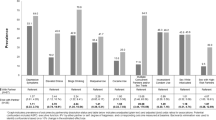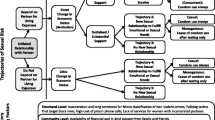Abstract
Incarceration is thought to influence HIV transmission by disrupting partnerships that provide support and protect against sex risk-taking. Current correctional facility-based family-strengthening programs focus on marital partnerships, a minority of inmates’ partnerships. Research on the sex partnerships of incarcerated African-American men and the types of partnerships most likely to protect against HIV-related sex risk is limited. Improved understanding can inform expansion of correctional facility-based family-strengthening programs to a greater proportion of protective partnerships and HIV risk reduction programs to partnerships vulnerable to sex risk. Project DISRUPT is a cohort study of African-American men being released from prison in North Carolina who were in committed heterosexual partnerships at prison entry. Using baseline survey data (N = 189), we conducted latent class analysis (LCA) to identify subgroups of participants with distinct relationship profiles and measured associations between relationship characteristics and multiple partnerships of inmates and their partners in the six months before incarceration. LCA indicated a two-class solution, with relationships distinguished by satisfaction/stability (satisfied/stable class: 58.0%; dissatisfied/unstable class: 42.0%); each class had comparable relationship length and levels of marriage and cohabitation. Dissatisfied/unstable relationships were associated with multiple partnerships among participants (AOR 2.93, 95% CI 1.50, 5.72) and partners (AOR 4.95, 95% CI 1.68, 14.58). Satisfaction indicators—versus length, marriage, or cohabitation—were the strongest independent correlates of inmates’ and partners’ multiple partnerships. Pre-incarceration economic deprivation, mental disorder symptoms, substance use, and violence in relationships were associated with dissatisfaction/instability. Prison-based programs designed to maintain healthy partnerships, strengthen relationship skills, and reduce HIV risk-taking and violence in relationships are warranted and should be targeted to both marital and nonmarital partnerships. Programming also should address the poverty, mental illness, and substance use factors that threaten relationship satisfaction/stability and increase HIV risk.

Similar content being viewed by others
References
Adimora, A. A., Schoenbach, V. J., Bonas, D. M., Martinson, F. E., Donaldson, K. H., & Stancil, T. R. (2002). Concurrent sexual partnerships among women in the United States. Epidemiology, 13(3), 320–327.
Adimora, A. A., Schoenbach, V. J., & Doherty, I. (2007). Concurrent sexual partnership among men in the US. American Journal of Public Health, 97, 2230–2237.
Adimora, A. A., Schoenbach, V. J., Martinson, F. E., Coyne-Beasley, T., Doherty, I., Stancil, T. R., & Fullilove, R. E. (2006). Heterosexually transmitted HIV infection among African Americans in North Carolina. Journal of Acquired Immune Deficiency Syndromes, 41(5), 616–623. doi:10.1097/01.qai.0000191382.62070.a5.
Adimora, A. A., Schoenbach, V. J., Taylor, E. M., Khan, M. R., & Schwartz, R. J. (2011). Concurrent partnerships, nonmonogamous partners, and substance use among women in the United States. American Journal of Public Health, 101(1), 128–136. doi:10.2105/Ajph.2009.174292.
Browning, S., Miller, S., & Lisa, M. (2001). Criminal incarceration dividing the ties that bind: Black men and their families. Journal of African American Men, 6(1), 87–102.
Carey, M. P., Senn, T. E., Seward, D. X., & Vanable, P. A. (2010). Urban African-American men speak out on sexual partner concurrency: Findings from a qualitative study. AIDS and Behavior, 14(1), 38–47. doi:10.1007/s10461-008-9406-0.
Centers for Disease Control and Prevention. (2013). Replicating effective programs plus: Connect: A couples-level intervention for heterosexual couples at risk for HIV/STIs. Retrieved from http://www.cdc.gov/hiv/prevention/research/rep/packages/connect.html.
Centers for Disease Control and Prevention. (2014). HIV among African Americans. Retrieved from http://www.cdc.gov/hiv/risk/racialethnic/aa/facts/index.html.
Coogan, P. F., Yu, J., O’Conner, G.T., Brown, T.A., Palmer, J.R., & Rosenberg, L. (2014). Depressive symptoms and the incidence of adult-onset asthma in African American women. Annals of Allergy, Asthma, & Immunology, 112(4), 333–338.e1. doi:10.1016/j.anai.2013.12.025.
El-Bassel, N., Gilbert, L., Wu, E., Witte, S. S., Chang, M., Hill, J., & Remien, R. H. (2011). Couple-based HIV prevention for low-income drug users from New York City: A randomized controlled trial to reduce dual risks. Journal of Acquired Immune Deficiency Syndromes, 58(2), 198–206. doi:10.1097/Qai.0b013e318229eab1.
Epperson, M. W., El-Bassel, N., Chang, M., & Gilbert, L. (2010a). Examining the temporal relationship between criminal justice involvement and sexual risk behaviors among drug-involved men. Journal of Urban Health, 87(2), 324–336. doi:10.1007/s11524-009-9429-5.
Epperson, M. W., Khan, M. R., Miller, D. P., Perron, B. E., El-Bassel, N., & Gilbert, L. (2010b). Assessing criminal justice involvement as an indicator of human immunodeficiency virus risk among women in methadone treatment. Journal of Substance Abuse Treatment, 38(4), 375–383. doi:10.1016/j.jsat.2010.03.004.
First, M. B., Spitzer, R. L., Gibbon, M., & Williams, J. B. W. (1995). The structured clinical interview for DSM-III-R personality-disorders (SCID-II). 1. Description. Journal of Personality Disorders, 9(2), 83–91.
Grieb, S. M., Davey-Rothwell, M., & Latkin, C. A. (2012). Concurrent sexual partnerships among urban African American high-risk women with main sex partners. AIDS and Behavior, 16(2), 323–333. doi:10.1007/s10461-011-9954-6.
Grinstead, O. A., Faigeles, B., Comfort, M., Seal, D., Nealey-Moore, J., Belcher, L., & Morrow, K. (2005). HIV, STD, and hepatitis risk to primary female partners of men being released from prison. Women and Health, 41(2), 63–80. doi:10.1300/J013v41n02_05.
Grinstead, O., Zack, B., & Faigeles, B. (2001). Reducing postrelease risk behavior among HIV seropositive prison inmates: The health promotion program. AIDS Education and Prevention, 13(2), 109–119.
Harawa, N., & Adimora, A. (2008). Incarceration, African Americans and HIV: Advancing a research agenda. Journal of the National Medical Association, 100(1), 57–62.
Khan, M. R., Behrend, L., Adimora, A. A., Weir, S. S., Tisdale, C., & Wohl, D. A. (2011a). Dissolution of primary intimate relationships during incarceration and associations with post-release STI/HIV risk behavior in a Southeastern city. Sexually Transmitted Diseases, 38(1), 43–47. doi:10.1097/Olq.0b013e3181e969d0.
Khan, M. R., Behrend, L., Adimora, A. A., Weir, S. S., White, B. L., & Wohl, D. A. (2011b). Dissolution of primary intimate relationships during incarceration and implications for post-release HIV transmission. Journal of Urban Health, 88(2), 365–375. doi:10.1007/s11524-010-9538-1.
Khan, M. R., Berger, A., Hemberg, J., O’Neill, A., Dyer, T. P., & Smyrk, K. (2013a). Non-injection and injection drug use and STI/HIV risk in the United States: The degree to which sexual risk behaviors versus sex with an STI-infected partner account for infection transmission among drug users. AIDS and Behavior, 17(3), 1185–1194. doi:10.1007/s10461-012-0276-0.
Khan, M. R., Doherty, I. A., Schoenbach, V. J., Taylor, E. M., Epperson, M. W., & Adimora, A. A. (2009). Incarceration and high-risk sex partnerships among men in the United States. Journal of Urban Health, 86(4), 584–601. doi:10.1007/s11524-009-9348-5.
Khan, M. R., Epperson, M., & Comfort, M. (2012). A novel conceptual model that describes the influence of arrest and incarceration on STI/HIV transmission. Paper presented at the American Public Health Association annual meeting, San Francisco, CA.
Khan, M. R., Epperson, M. W., Mateu-Gelabert, P., Bolyard, M., Sandoval, M., & Friedman, S. R. (2011c). Incarceration, sex with an STI- or HIV-infected partner, and infection with an STI or HIV in Bushwick, Brooklyn, NY: A social network perspective. American Journal of Public Health, 101(6), 1110–1117. doi:10.2105/AJPH.2009.184721.
Khan, M. R., Golin, C. E., Friedman, S. R., Scheidell, J. D., Adimora, A. A., Judon-Monk, S., … Wohl, D. A. (2015). STI/HIV sexual risk behavior and prevalent STI among incarcerated African American men in committed partnerships: The significance of poverty, mood disorders, and substance use. AIDS and Behavior. doi:10.1007/s10461-015-1062-6.
Khan, M. R., Scheidell, J. D., Gaydos, C. A., Coatsworth, A. M., & Latimer, W. W. (2013). Marital status and sexually transmitted infection risk among non-injection and injection drug users. Paper presented at the American Public Health Association annual meeting, Boston, MA.
Kukorowski, D. (2012). The price to call home: State-sanctioned monopolization in the prison phone industry. Retrieved from http://www.prisonpolicy.org/phones/report.html.
Magidson, J., & Vermunt, J. K. (2004). Latent class models handbook of quantitative methodology for social science. Newbury Park, CA: Sage.
Mazzaferro, K. E., Murray, P. J., Ness, R. B., Bass, D. C., Tyus, N., & Cook, R. L. (2006). Depression, stress, and social support as predictors of high-risk sexual behaviors and STIs in young women. Journal of Adolescent Health, 39(4), 601–603. doi:10.1016/j.jadohealth.2006.02.004.
Muthén, B., & Muthén, B. O. (1998–2007). Mplus user’s guide (5th ed.). Los Angeles, CA: Muthén & Muthén.
Radloff, L. (1977). The CES-D Scale: A self-report depression scale for research in the general population. Applied Psychological Measurement, 1, 385–401.
Raj, A., Santana, M. C., La Marche, A., Amaro, H., Cranston, K., & Silverman, J. G. (2006). Perpetration of intimate partner violence associated with sexual risk behaviors among young adult men. American Journal of Public Health, 96(10), 1873–1878. doi:10.2105/AJPH.2005.081554.
Sabourin, S., Valois, P., & Lussier, Y. (2005). Development and validation of a brief version of the dyadic adjustment scale with a nonparametric item analysis model. Psychological Assessment, 17(1), 15–27. doi:10.1037/1040-3590.17.1.15.
Senn, T. E., Scott-Sheldon, L. A., Seward, D. X., Wright, E. M., & Carey, M. P. (2011). Sexual partner concurrency of urban male and female STD clinic patients: A qualitative study. Archives of Sexual Behavior, 40(4), 775–784. doi:10.1007/s10508-010-9688-y.
Simpson, J. A. (1987). The dissolution of romantic relationships—Factors involved in relationship stability and emotional distress. Journal of Personality and Social Psychology, 53(4), 683–692. doi:10.1037//0022-3514.53.4.683.
Spanier, G. B. (1976). Measuring dyadic adjustment: New scales for assessing the quality of marriage and similar dyads. Journal of Marriage and the Family, 38(1), 15–28.
Straus, M. A., Hamby, S. L., BoneyMcCoy, S., & Sugarman, D. B. (1996). The revised Conflict Tactics Scales (CTS2)—Development and preliminary psychometric data. Journal of Family Issues, 17(3), 283–316. doi:10.1177/019251396017003001.
U.S. Department of Health and Human Services. (2008). Incarceration and the family: A review of research and promising approaches for serving fathers and families. Retrieved from http://aspe.hhs.gov/hsp/08/mfs-ip/incarceration&family/index.shtml.
Wilson, B., & Stuchbury, R. (2010). Do partnerships last? Comparing marriage and cohabitation using longitudinal census data. Population Trends, 139, 37–63. doi:10.1057/pt.2010.4.
Zhan, W., Hansen, N. B., Shaboltas, A. V., Skochilov, R. V., Kozlov, A. P., Krasnoselskikh, T. V., & Abdala, N. (2012). Partner violence perpetration and victimization and HIV risk behaviors in St. Petersburg, Russia. Journal of Traumatic Stress, 25(1), 86–93. doi:10.1002/jts.21658.
Acknowledgements
This study was funded by NIH NIDA R01DA028766 (PI: Khan), University of North Carolina Center for AIDS Research [AI050410] and NIH 1K24HD059358 (Dr. Adimora); Dr. Golin’s salary was partially supported by K24 HD06920.
Author information
Authors and Affiliations
Corresponding author
Ethics declarations
Conflict of interest
All authors declare they have no conflicts of interest.
Ethical Approval
All procedures performed in the study involving human participants were in accordance with the ethical standards of the institutional and/or national research committee and with the 1964 Helsinki Declaration and its later amendments or comparable ethical standards.
Informed Consent
Informed consent was obtained from all individual participants included in the study.
Rights and permissions
About this article
Cite this article
Khan, M.R., El-Bassel, N., Golin, C.E. et al. The Committed Intimate Partnerships of Incarcerated African-American Men: Implications for Sexual HIV Transmission Risk and Prevention Opportunities. Arch Sex Behav 46, 2173–2185 (2017). https://doi.org/10.1007/s10508-016-0916-y
Received:
Revised:
Accepted:
Published:
Issue Date:
DOI: https://doi.org/10.1007/s10508-016-0916-y




